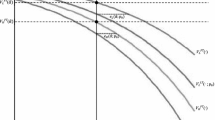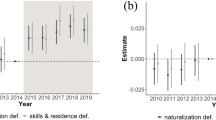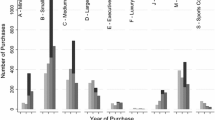Abstract
The suspension of a driver’s license or the revocation of a passport or a professional license are used by the tax authorities as sanctions for failure to comply with tax obligations and are referred to as collateral tax sanctions. In this paper, I propose a new rationale for why it may be beneficial to use collateral tax sanctions for the purpose of tax enforcement. By affecting consumption and providing enforcement targeted to a group, collateral tax sanctions may allow the government to impose punishment correlated with an individual’s earning potential. Such punishment also makes the effective tax rates correlated with an individuals’ earning potential and therefore leads to a more effective redistribution of income. I show that the use of collateral tax sanctions could increase the CES social welfare function when the skill distribution of the targeted group first-order stochastically dominates the skill distribution of the other group and the social welfare function is sufficiently concave.
Similar content being viewed by others
Notes
See, e.g., Tax Topics, Louisiana Department of Revenue, Volume 24 Number 2 April 2004, available at http://www.revenue.louisiana.gov/forms/publications/tt(04_04).pdf. See also Suspension and Denial of Renewal of Drivers’ Licenses (LAC 61:I.1355), Louisiana Department of Revenue, available at http://revenue.louisiana.gov/forms/lawspolicies/LAC61_I_1355.pdf.
See, e.g., California to Tax Scofflaws: Pay Up or Lose your Driver’s (or CPA) License, AccountingWeb.com, September 20, 2011, available at http://www.accountingweb.com/topic/tax/california-tax-scofflaws-pay-or-lose-your-drivers-license. See also Franchise Tax Board Meeting, September 5, 2012: Delinquent Taxpayer Accountability Act Informational Item available at https://www.ftb.ca.gov/law/meetings/attachments/090512/3.pdf.
See, e.g., States target tax scofflaws with incentives and shame, usatoday.com, October 16, 2013, available at http://www.usatoday.com/story/news/nation/2013/10/16/states-target-tax-scofflaws/2993447/. See also Summary of Budget Bill Personal Income Tax Changes Enacted in 2013, New York State Department of Taxation and Finance, August 8, 2013, available at http://www.tax.ny.gov/pdf/memos/income/m13_4i.pdf.
See Jay Soled, Using Driving Privilege to Solve States’ Fiscal Crises, 60 STATE TAX NOTES 841 (June 13, 2011).
See, e.g., Wis. Stat. §73.0301(d)(11) (revocation of law licenses); Min Stat. §270C.72 (revocation of medical licenses).
See, e.g., Louisiana Dep’t of Wildlife and Fisheries, Hunting Licenses, available at http://www.wlf.louisiana.gov/licenses/hunting-licenses (last visited Oct. 22, 2012).
See Blank (2014) for more details.
The National Travel and Tourism Office is located in the International Trade Administration of the Department of Commerce.
This presumes that the cost associated with collateral sanctions are proportional to income. For instance, suspension of a passport is more costly for an individual with a high earning potential. In general, there is not much known about how the cost from the imposition of a collateral tax sanction depends on individual earning potential and hence on income.
For a detailed discussion of the properties of this monotone transformation of the CES SWF see Iritani and Miyakawa (2002).
Note that the total tax revenue increases with the effective tax rate, \(\frac{\partial TR}{\partial \theta _{0}t_{0}}=\frac{\eta }{\theta }\int _{\underline{w}}^{\overline{w}}(I(w)-\theta _{0}t_{0}\frac{\partial I(w)}{\partial \theta _{0}t_{0}})f(w)\mathrm{d}w=\widetilde{I}>0\). However, the tax revenue collected from a w-type individual may not increase with the effective tax rate, because \(\frac{\partial TR(w)}{\partial \theta _{0}t_{0}}=\frac{\eta _{0}}{\theta _{0}}\left( I(w)-\theta _{0}t_{0}\frac{\partial I(w)}{\partial \theta _{0}t_{0}}\right) =\frac{\eta _{0}}{\theta _{0}}\left( I(w)-\theta _{0}t_{0}\frac{w^{2}}{\varphi ^{''}(\frac{I}{w})}\right) =\frac{\eta _{0}}{\theta _{0}}I(w)\left( 1-\epsilon (w)\frac{\eta _{0}\int _{\underline{w}}^{\overline{w}}I(w)f(w)\mathrm{d}w-\theta _{0}\widetilde{I}}{\eta _{0}\int _{\underline{w}}^{\overline{w}}\epsilon (w)I(w)f(w)\mathrm{d}w}\right) \), which could be positive or negative depending on the size and behavior of \(\epsilon (w)\). The reason for this is that an increase in the effective tax rate has two effects on the tax revenue. The first effect is a mechanical effect: an increase in the tax rate gives a higher tax revenue from each dollar of income. This effect increases the tax revenue. The second effect is a labor supply effect: an increase in the tax rate reduces the labor supplied by an individual. This second effect decreases the tax revenue. The total effect of an increase in the tax rate on the tax revenue is determined by the size of those two effects. Note that if the inverse of the wage elasticity of labor supply is constant (i.e., \(\epsilon (w)=\epsilon =\mathrm{const}\)) then the tax revenue collected from a w-type individual increases with the effective tax rate for all w, \(\frac{\partial TR(w)}{\partial \theta _{0}t_{0}}=I(w)\frac{\widetilde{I}}{\int _{\underline{w}}^{\overline{w}}\epsilon (w)I(w)f(w)\mathrm{d}w}\).
Note that this condition is condition (26) in the case of Rawlsian s.w.f. which implies that the imposition of the collateral tax sanction is socially beneficial.
Note that this condition is easily satisfied if \(\underline{w}_{1}\) is close to zero.
The tax revenue paid by taxpayers in group 2 is \(TR_{2}=\rho _{2}t\left( \frac{1-\theta _{2}t}{1+1/\epsilon }\right) ^{\epsilon }\hat{W}_{2}\), and it could increases or decrease because \(\frac{\partial TR_{2}}{\partial \theta _{2}}=\left( \frac{1-\theta _{2}t}{1+1/\epsilon }\right) ^{\epsilon }\hat{W}_{2}\left[ \frac{\underline{W}_{2}}{\hat{W}_{1}+\hat{W}_{2}}\left. \frac{\partial \theta _{2}t}{\partial \theta _{2}}\right| _{\theta _{2}=\theta _{0}}-t_{0}\left( \frac{\rho _{0}}{\theta _{0}}-\left. \frac{\partial \rho _{2}}{\partial \theta _{2}}\right| _{\theta _{2}=\theta _{0}}\right) \right] \gtrless 0\) depending of the size of \(\left. \frac{\partial \rho _{2}}{\partial \theta _{2}}\right| _{\theta _{2}=\theta _{0}}\). It is positive if \(\left. \frac{\partial \rho _{2}}{\partial \theta _{2}}\right| _{\theta _{2}=\theta _{0}}\) is not much less than \(\frac{\rho _{0}}{\theta _{0}}\).
References
Akerlof, G. A. (1978). The economics of tagging as applied to the optimal income tax, welfare programs, and manpower planning. The American Economic Review, 68(1), 8–19.
Andreoni, J. (1991). Reasonable doubt and the optimal magnitude of fines: Should the penalty fit the crime? The RAND Journal of Economics, 22(3), 385–395.
Andreoni, J. (1992). IRS as loan shark: Tax compliance with borrowing constraints. Journal of Public Economics, 49, 35–46.
Becker, G. S. (1968). Crime and punishment: An economic approach. Journal of Political Economy, 76(2), 169–217.
Blank, J. D. (2014). Collateral compliance. University of Pennsylvania Law Review, 162, 719.
Cremer, H., Gahvari, F., & Lozachmeur, J.-M. (2010). Tagging and income taxation: Theory and an application. American Economic Journal: Economic Policy, 2(1), 31–50.
D’Antoni, M., & Galbiati, R. (2007). A signaling theory of nonmonetary sanctions. International Review of Law and Economics, 27, 204–218.
Iritani, J., & Miyakawa, T. (2002). A note on the monotone transformation of CES social welfare functions. Kobe University Economic Review, 48, 19–28.
Kopczuk, W. (2001). Redistribution when avoidance behavior is heterogeneous. Journal of Public Economics, 81(1), 51–71.
Polinsky, A. M., & Shavell, S. (1984). The optimal use of fines and imprisonment. Journal of Public Economics, 24, 89–99.
Tanzi, V. (1998). Corruption around the world: Causes, consequences, scope, and cures. IMF Staff Papers, 45, 559–94.
Acknowledgements
I am grateful for comments and advice from Joel Slemrod, Tilman Börgers, Wojciech Kopczuk, James R. Hines Jr., Katherine Cuff, Ron Davies, Mark Phillips, Matthew Rablen, Uday Rajan, Suranjali Tandon, and the two anonymous referees. I wish to thank participants at the Michigan Public Finance Free Lunch and Regular Seminars, the National Tax Association Meeting 2015, and International Institute of Public Finance Annual Congress 2016.
Author information
Authors and Affiliations
Corresponding author
Appendices
Appendix
A Proofs
Proof of Proposition 1
The FOCs the determines the optimal evasion levels \(E_{1}(I,t)\) and \(E_{2}(I,t)\) are \(t=\frac{\partial D_{1}(I,E_{1}^{*})}{\partial E}\) and \(t=\frac{\partial D_{2}(I,E_{2}^{*})}{\partial E}\). Because \(D_{i}(I,E)\) for \(i=1,2\) strictly convex and \(\frac{\partial D_{2}(I,E)}{\partial E}>\frac{\partial D_{1}(I,E)}{\partial E}\), these FOCs imply that \(E_{1}^{*}>E_{2}^{*}\). Hence, \(\eta _{2}-\eta _{1}=\frac{1}{I}(E_{1}^{*}-E_{2}^{*})>0\) and \(\theta _{2}-\theta _{1}=\frac{1}{I}(E_{1}^{*}-E_{2}^{*})-\frac{1}{tI}(D_{1}(E_{1}^{*})-D_{2}(E_{2}^{*}))=\frac{1}{tI}[t(E_{1}^{*}-E_{2}^{*})-(D_{1}(E_{1}^{*})-D_{1}(E_{2}^{*})+D_{1}(E_{2}^{*})-D_{2}(E_{2}^{*}))]>\) \(\frac{1}{tI}[t(E_{1}^{*}-E_{2}^{*})-\frac{\partial D_{1}(E_{1}^{*})}{\partial E}(E_{1}^{*}-E_{2}^{*})+(D_{2}(E_{2}^{*})-D_{1}(E_{2}^{*}))=\frac{1}{tI}[(D_{2}(E_{2}^{*})-D_{1}(E_{2}^{*})]>0\), where \(D_{1}(E_{1}^{*})-D_{1}(E_{2}^{*})<\frac{\partial D_{1}(E_{1}^{*})}{\partial E}(E_{1}^{*}-E_{2}^{*})\) because \(D_{1}(\cdot )\) is strictly convex in E, and \((D_{2}(E_{2}^{*})-D_{1}(E_{2}^{*})>0\) because \(D_{i}(I,0)=0\) \(i=1,2\), and \(\frac{\partial D_{2}(I,E)}{\partial E}>\frac{\partial D_{1}(I,E)}{\partial E}\). \(\square \)
Proof of Lemma 1
Note first that from Eq. (9) it follows that utility function u(w) is strictly increasing on \([\underline{w},\overline{w}]\) because “information rent” is positive. That is, \(\underset{w}{min}u(w)=u(\underline{w})\).
-
(i)
When \(\rho \) converges to zero, the result is straightforward. Indeed,
$$\begin{aligned} \underset{\rho =0}{lim}\beta (w)=\underset{\rho =0}{lim}\frac{u(w)^{-\rho }}{\int u(w)^{-\rho }f(w)\mathrm{d}w}=\frac{u(w)^{0}}{\int u(w)^{0}f(w)\mathrm{d}w}=\frac{1}{\int f(w)\mathrm{d}w}=1. \end{aligned}$$ -
(ii)
Consider \(\rho \) converges to \(\infty \). Define function \(\gamma (w)=\frac{u(\underline{w})}{u(w)}\). Because \(u(\underline{w})\) is strictly increasing on \([\underline{w},\overline{w}]\), function \(\gamma (w)\) is strictly decreasing on \([\underline{w},\overline{w}]\) and \(\gamma (\underline{w})=1\).
Consider \(w=\underline{w}\). Then,
Let me show that \(\underset{\rho =\infty }{lim}\int \gamma (s)^{\rho }f(s)\mathrm{d}s=0\). By the definition of the limit, we need to show that \(\forall \varepsilon >0\) \(\exists \rho _{0}\) such that \(\forall \rho \ge \rho _{0}\) \(\int _{\underline{w}}^{\overline{w}}\gamma (s)^{\rho }f(s)\mathrm{d}s\le \varepsilon \). Indeed, define \(f_{H}=\underset{w\in [\underline{w},\overline{w}]}{max}f(w)\). By the assumptions, \(f_{H}\) is positive and bounded. For any given \(\varepsilon >0\), define \(\rho _{0}\) such that \(\gamma (\underline{w}+\frac{\varepsilon }{2f_{H}})^{\rho _{0}}\le \frac{\varepsilon }{2}\). Such \(\rho _{0}\) exists because \(0<\gamma (\underline{w}+\frac{\varepsilon }{2f_{H}})<1\). Then, for \(\forall \rho \ge \rho _{0}\) \(\int _{\underline{w}}^{\overline{w}}\gamma (s)^{\rho }f(s)\mathrm{d}s=\int _{\underline{w}}^{\underline{w}+\frac{\varepsilon }{2f_{H}}}\gamma (s)^{\rho }f(s)\mathrm{d}s+\int _{\underline{w}+\frac{\varepsilon }{2f_{H}}}^{\overline{w}}\gamma (s)^{\rho }f(s)\mathrm{d}s\le \gamma (\underline{w})^{\rho }f_{H}\frac{\varepsilon }{2f_{H}}+\gamma (\underline{w}+\frac{\varepsilon }{2f_{H}})^{\rho }\int _{\underline{w}}^{\overline{w}}f(s)\mathrm{d}s=\frac{\varepsilon }{2}+\frac{\varepsilon }{2}=\varepsilon \).
Consider \(w>\underline{w}\). Then, \(\underset{\rho =\infty }{lim}\beta (w)=\underset{\rho =\infty }{lim}\frac{\gamma (w)^{\rho }}{\int \gamma (s)^{\rho }f(s)\mathrm{d}s}=\underset{\rho =\infty }{lim}\frac{1}{\int (\gamma (s)/\gamma (w))^{\rho }f(s)\mathrm{d}s}=\frac{1}{\infty }=0\). Let me now show that \(\underset{\rho =\infty }{lim}\int _{\underline{w}}^{\overline{w}}(\gamma (s)/\gamma (w))^{\rho }f(s)\mathrm{d}s=\infty \). Indeed, \(\underset{\rho =\infty }{lim}\int _{\underline{w}}^{\overline{w}}(\gamma (s)/\gamma (w))^{\rho }f(s)\mathrm{d}s=\underset{\rho =\infty }{lim}\int _{\underline{w}}^{w}(\gamma (s)/\gamma (w))^{\rho }f(s)\mathrm{d}s+\underset{\rho =\infty }{lim}\int _{w}^{\overline{w}}(\gamma (s)/\gamma (w))^{\rho }f(s)\mathrm{d}s=\infty +0=\infty \), where the second limit \(\underset{\rho =\infty }{lim}\int _{w}^{\overline{w}}(\gamma (s)/\gamma (w))^{\rho }f(s)\mathrm{d}s\) converges to zero because for \(s>w\) \(\gamma (s)/\gamma (w)<1\) and the same consideration as in the previous case are applied. On the other hand, the first limit \(\underset{\rho =\infty }{lim}\int _{\underline{w}}^{w}(\gamma (s)/\gamma (w))^{\rho }f(s)\mathrm{d}s\) converges to \(\infty \) because for \(\underline{w}\le s<w\) \(\gamma (s)/\gamma (w)>1\). Let me show this formally by relying on the definition of the limit. Define \(f_{L}=\underset{w\in [\underline{w},\overline{w}]}{min}f(w)\). By the assumptions, \(f_{L}\) exists and is positive. For any given \(\varepsilon >0\), define \(\rho _{0}\) such that \((\gamma (\frac{\underline{w}+w}{2})/\gamma (w))^{\rho _{0}}f_{L}\frac{w-\underline{w}}{2}>\varepsilon \). Then, for \(\forall \rho \ge \rho _{0}\) \(\int _{\underline{w}}^{w}(\gamma (s)/\gamma (w))^{\rho }f(s)\mathrm{d}s>(\gamma ((w+\underline{w})/2)/\gamma (w))^{\rho }\int _{\underline{w}}^{(w+\underline{w})/2}f(s)\mathrm{d}s+\int _{(w+\underline{w})/2}^{w}f(s)\mathrm{d}s\ge (\gamma ((w+\underline{w})/2)/\gamma (w))^{\rho }f_{L}\frac{w-\underline{w}}{2}+f_{L}\frac{w-\underline{w}}{2}>\varepsilon \). \(\square \)
Proof of Lemma 2
The derivative of the social welfare function w.r.t. \(\theta _{0}\) is
where \(\hat{I}=\int I(w)f(w)\mathrm{d}w\) is the average income. Thus, \(\frac{\partial \mathrm{SWF}}{\partial \theta _{0}}\) is greater, equal or less than zero if \(\frac{\partial \eta _{0}}{\partial \theta _{0}}\) is greater, equal or less than \(\frac{\eta _{0}}{\theta _{0}}\). \(\square \)
Proof of Lemma 3
-
(i)
First, because distribution \(F_{2}(w)\) first-order stochastically dominates distribution \(F_{2}(w)\) and function \(w^{1+\epsilon }\) is strictly increasing, it follows that \(\hat{W}_{2}>\hat{W}_{1}\). Hence, \(\widetilde{W}_{1}/\hat{W}_{1}-\widetilde{W}_{2}/\hat{W}_{2}>0\). Second, define \(\rho _{0}=1+\frac{G_{0}}{\alpha _{0}\underline{w}_{1}}\), where \(G_{0}=\eta _{0}t_{0}\left( \frac{1-\theta _{0}t_{0}}{1+1/\epsilon }\right) ^{\epsilon }\sum _{i=1,2}\int w^{1+\epsilon }\frac{f_{i}(w)}{2}\mathrm{d}w-R\) and \(\alpha _{0}=\frac{1}{\epsilon }\left( \frac{1-\theta _{0}t_{0}}{1+1/\epsilon }\right) ^{1+\epsilon }\) then \(\left. \beta _{i}(w)\right| _{\theta _{2}=\theta _{0}}=\frac{(\alpha _{0}w^{1+\epsilon }+G_{0})^{-\rho }}{\zeta }\), where \(\zeta =\sum _{i=1,2}\int u_{i}(w)^{1-\rho }\frac{f_{i}(w)}{2}\mathrm{d}w\). Let me now show that if \(\rho \ge \rho _{0}\) then \(\beta (w)w^{1+\epsilon }\) is strictly decreasing function. Indeed, \(\frac{\partial (\beta (w)w^{1+\epsilon })}{\partial w}=\frac{\partial }{\partial w}(\frac{\zeta w^{1+\epsilon }}{(\alpha _{0}w^{1+\epsilon }+G_{0})^{\rho }})=\frac{\zeta (1+\epsilon )w^{\epsilon }}{(\alpha _{0}w^{1+\epsilon }+G_{0})^{\rho +1}}(G_{0}-(\rho -1)\alpha _{0}w^{1+\epsilon })<0\) for \(\rho \ge \rho _{0}\). Because distribution \(F_{2}(w)\) first-order stochastically dominates distribution \(F_{2}(w)\) and \(\beta (w)w^{1+\epsilon }\) is strictly decreasing function, it follows that \(-\widetilde{W}_{1}<-\widetilde{W}_{2}\) and \(\hat{W}_{2}>\hat{W}_{1}\). Hence, \(\widetilde{W}_{1}/\hat{W}_{1}>\widetilde{W}_{2}/\hat{W}_{1}>\widetilde{W}_{2}/\hat{W}_{2}\).
-
(ii)
According to Lemma 1, \(\underset{\rho =\infty }{lim}\beta _{1}(w)={\left\{ \begin{array}{ll} \infty , &{} if\,w=\underline{w}_{1}\\ 0, &{} if\,w>\underline{w}_{1} \end{array}\right. }\) and \(\underset{\rho =\infty }{lim}\beta _{2}(w)=0\) for \(w\in [\underline{w}_{2},\overline{w}_{2}]\) because \(\underline{w}_{1}=min\{\underline{w}_{1},\underline{w}_{2}\}\). Hence, \(\widetilde{W}_{2}=0\) and \(\widetilde{W}_{1}>0\). Therefore, \(\widetilde{W}_{1}/\hat{W}_{1}-\widetilde{W}_{2}/\hat{W}_{2}>0\).\(\square \)
Proof of Lemma 4
-
(i)
According to (8), the FOCs are \(1-\theta _{i}t=\frac{1}{\underline{w}_{i}}\varphi ^{'}(\frac{I_{i}(\underline{w}_{i})}{\underline{w}_{i}})\), for \(i=1,2\). Because \(\varphi \) is strictly convex and \((1-\theta _{2})\underline{w}_{2}>(1-\theta _{1})\underline{w}_{1}\), these FOCs imply \(L_{2}(\underline{w}_{2})>L_{1}(\underline{w}_{1})\). Then, \(u_{2}(\underline{w}_{2})-u_{1}(\underline{w}_{1})=I_{2}(\underline{w}_{2})(1-\theta _{2}t)-I_{1}(\underline{w}_{1})(1-\theta _{1}t)-[\varphi (L_{2}(\underline{w}_{2}))-\varphi (L_{1}(\underline{w}_{1}))]>\) \(I_{2}(\underline{w}_{2})(1-\theta _{2}t)-I_{1}(\underline{w}_{1})(1-\theta _{1}t)-(1-\theta _{2}t)\underline{w}_{2}(\frac{I_{2}(\underline{w}_{2})}{\underline{w}_{2}}-\frac{I_{1}(\underline{w}_{1})}{\underline{w}_{1}})=((1-\theta _{2}t)\underline{w}_{2}-(1-\theta _{1})\underline{w}_{1})\frac{I_{1}(\underline{w}_{1})}{\underline{w}_{1}}>0\), where I have used that \(\varphi (L_{2}(\underline{w}_{2}))-\varphi (L_{1}(\underline{w}_{1}))<\varphi ^{'}(L_{2}(\underline{w}_{2}))\left( L_{2}(\underline{w}_{2})-L_{1}(\underline{w}_{1})\right) \).
-
(ii)
If \((1-\theta _{2})\underline{w}_{2}>(1-\theta _{1})\underline{w}_{1}\), then according to part i) of this lemma \(\underline{u}_{1}<\underline{u}_{2}\). Hence, according to Lemma 1, \(\underset{\rho =\infty }{lim}\beta _{1}(w)={\left\{ \begin{array}{ll} \infty , &{} if\,w=\underline{w}_{1}\\ 0, &{} if\,w>\underline{w}_{1} \end{array}\right. }\) and \(\underset{\rho =\infty }{lim}\beta _{2}(w)=0\) for \(w\in [\underline{w}_{2},\overline{w}_{2}]\). Therefore, formula (22) reduces to (27). \(\square \)
Proof of Proposition 3
Note that formula (27) for \(t_{0}\) when \(\theta _{1}=\theta _{2}=\theta _{0}\) reduces to
where I used that \(\int _{\underline{w}}^{\overline{w}}w^{1+\epsilon }f(w)\mathrm{d}w=\int _{\underline{w}}^{\overline{w}}w^{1+\epsilon }\frac{f_{1}(w)}{2}\mathrm{d}w+\int _{\underline{w}}^{\overline{w}}w^{1+\epsilon }\frac{f_{2}(w)}{2}\mathrm{d}w\).
To determine the sign of the change in the tax rate as a result of an increase in the effective tax factor, differentiate (27) w.r.t. \(\theta _{2}\) and estimate the derivative \(\frac{\partial t}{\partial \theta _{2}}\) at \(\theta _{2}=\theta _{0}\) to get
where the last term in the above equation is negative because \(\left. \frac{\partial \eta _{2}}{\partial \theta _{2}}\right| _{\theta _{2}=\theta _{0}}-\frac{\eta _{0}}{\theta _{0}}<0\).
For \(\left. \frac{\partial t}{\partial \theta _{2}}\right| _{\theta _{2}=\theta _{0}}\) to be negative, it is sufficient to have \(\frac{\eta _{0}}{\theta _{0}}(\hat{W}_{1}+\hat{W}_{2})-2\underline{W}_{1}>0\).Footnote 13 This implies that the average skill level should be sufficiently higher than the lowest skill level. If so, the optimal tax rate decreases with an increase in the effective tax factor, implying that tax revenue collected from taxpayers in group 1 decreases. The effective tax rate in group 2, however, increases, because \(\left. \frac{\partial \theta _{2}t}{\partial \theta _{2}}\right| _{\theta _{2}=\theta _{0}}=\frac{t_{0}}{\hat{W}_{1}+\hat{W}_{2}}\left( \hat{W}_{1}+\frac{\epsilon \theta _{0}t_{0}\hat{W}_{2}\underline{W}_{1}^{2}}{(\frac{\eta _{0}}{\theta _{0}}(\hat{W}_{1}+\hat{W}_{2})-\underline{W}_{1})^{2}}\right) -\frac{t_{0}\hat{W}_{2}}{(\hat{W}_{1}+\hat{W}_{2})}\frac{\epsilon \theta _{0}t_{0}\hat{W}\underline{W}_{1}}{(\frac{\eta _{0}}{\theta _{0}}(\hat{W}_{1}+\hat{W}_{2})-\underline{W}_{1})^{2}}\left( \frac{\eta _{0}}{\theta _{0}}-\left. \frac{\partial \eta _{2}}{\partial \theta _{2}}\right| _{\theta _{2}=\theta _{0}}\right)>\frac{t_{0}\hat{W}_{1}}{\hat{W}_{1}+\hat{W}_{2}}>0\) assuming that \(\left. \frac{\partial \eta _{2}}{\partial \theta _{2}}\right| _{\theta _{2}=\theta _{0}}>\frac{\eta _{0}}{\theta _{0}}-\frac{min\{\underline{W}_{1},\underline{W}_{2}\}}{\hat{W}_{1}+\hat{W}_{2}}\).Footnote 14 When the effective tax factor in group 2 increases, the lump-sum transfer also increases, because \(\left. \frac{\partial G}{\partial \theta _{2}}\right| _{\theta _{2}=\theta _{0}}=(1+\frac{1}{\epsilon })^{-\epsilon }(1-\theta _{0}t)^{\epsilon }(1-\epsilon \frac{\theta _{0}t_{0}}{1-\theta _{0}t_{0}})\frac{\epsilon \eta _{0}\theta _{0}\hat{W}_{2}\underline{W}_{1}^{2}}{(\eta _{0}(1+\epsilon )(\hat{W}_{1}+\hat{W}_{2})-\theta _{0}\underline{W}_{1})^{2}}>0\) presuming \(\left. \frac{\partial \eta _{2}}{\partial \theta _{2}}\right| _{\theta _{2}=\theta _{0}}=\frac{_{0}}{\theta _{0}}\). This means that the increase in the taxes paid by taxpayers in group 2 outweighs the decrease in the taxes paid by taxpayers in group 1.
The expression for \(\underline{u}_{i}(w)\) and for \(u_{i}(w)\) for \(i=1,2\) are now
By differentiating the above utilities w.r.t. \(\theta _{2}\), we can determine how an increase in the effective tax factor in group 2 affects the utilities of individuals in each group. In doing this, remember that now \(\frac{\partial \underline{u}_{1}}{\partial t}=0\), because t is chosen to maximize \(\underline{u}_{1}\). The derivatives of the utilities w.r.t. \(\theta _{2}\) are
where the estimate of the sign of \(\left. \frac{\partial \underline{u}_{1}}{\partial \theta _{2}}\right| _{\theta _{2}=\theta _{0}}\) presuming that \(\left. \frac{\partial \eta _{2}}{\partial \theta _{2}}\right| _{\theta _{2}=\theta _{0}}\) is not too small, specifically, that \(\left. \frac{\partial \eta _{2}}{\partial \theta _{2}}\right| _{\theta _{2}=\theta _{0}}>\frac{\eta _{0}}{\theta _{0}}-\frac{min\{\underline{W}_{1},\underline{W}_{2}\}}{\hat{W}_{1}+\hat{W}_{2}}\).
These derivatives imply that everyone in group 2 receives a loss in their welfare and everyone in group 1 receives a gain in their welfare as a result of an increase in the effective tax factor in group 2. Because the Rawlsian social welfare function in this case is equal to \(\underline{u}_{1}\), social welfare increases. \(\square \)
B Relaxation of the assumptions
I now relax the assumption that the gross effective tax factor and the net effective tax factor do not depend on the tax rate, that is, I now presume that \(\theta (t)\) and \(\eta (t)\). To separate the influence of the tax rate on \(\theta \) and \(\eta \) from the influence of the collateral tax sanction, I denote the collateral tax sanction by s. I assume that when the collateral tax sanction is imposed (\(s>0\)), we have \(\frac{\partial \theta _{2}}{\partial s}>0\) (\(\frac{\partial \eta _{2}}{\partial s}>0\)) and \(\frac{\partial \theta _{1}}{\partial s}=0\) (\(\frac{\partial \eta _{1}}{\partial s}=0\)).
First, note that the FOC describing the solution of the individual problem does not change, that is, \((1-\theta _{i}(t)t)=\frac{1}{w}\varphi ^{'}(\frac{I_{i}(w)}{w})\). However, the derivative of income w.r.t. the tax rate is now \(\frac{\partial I_{i}}{\partial t}=-\frac{\theta _{i}+t\frac{\partial \theta _{i}}{\partial t}}{1-\theta _{i}t}\epsilon (w)I_{i}(w)\).
Second, under the assumption that the labor supply elasticity exhibits a constant wage elasticity (\(\varphi (L)=L^{1+1/\epsilon }\), \(\epsilon >0\)), the FOC characterizing the optimal tax rate is now
and Eq. (23) determining \(t_{0}\) is now
where \(\hat{W}_{i}=\int w^{1+\epsilon }\frac{f_{i}(w)}{2}\mathrm{d}w\), \(\widetilde{W}_{i}=\int \beta _{i}(w)w^{1+\epsilon }\frac{f_{i}(w)}{2}\mathrm{d}w\), \(\hat{W}=\int w^{1+\epsilon }f(w)\mathrm{d}w=\hat{W}_{1}+\hat{W}_{2}\), and \(\widetilde{W}=\int \beta (w)w^{1+\epsilon }f(w)\mathrm{d}w=\widetilde{W}_{1}+\widetilde{W}_{2}\).
Finally, the derivative of (24) w.r.t. s can be expressed as:
This equation is analogous to Eq. (25) and leads to the following condition for the collateral tax sanction to be socially beneficial:
Thus, the use of the collateral tax sanction could improve social welfare when the social welfare function is sufficiently concave and the skill distribution in group 2 first-order stochastically dominates the skill distribution in group 1.
Rights and permissions
About this article
Cite this article
Kuchumova, Y. A collateral tax sanction: When does it mimic a welfare-improving tag?. Int Tax Public Finance 25, 841–866 (2018). https://doi.org/10.1007/s10797-017-9480-1
Published:
Issue Date:
DOI: https://doi.org/10.1007/s10797-017-9480-1




